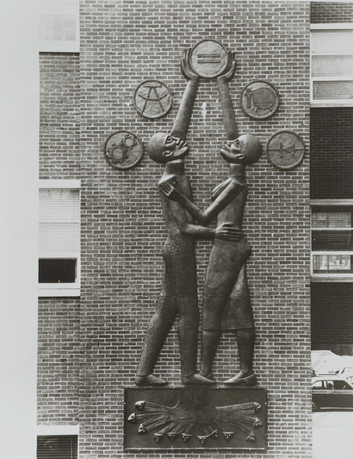Elizabeth Catlett
 Elizabeth Catlett
Elizabeth Catlett
Artist, Sculptor (1915-2012)
----------------------------------------------------
"I have always wanted my art to service my people - to reflect us, to relate to us, to stimulate us, to make us aware of our potential. We have to create an art for liberation and for life."
Elizabeth Catlett spent her early years in Washinton D.C. Both of her grandparents were freed enslaved people which was a narrative that played a very central role to her scultptures, paintings, and prints. Her sculptures are known for their round, intuitive physicality and often depict mothers and their children. Her printmaking usually depicted what she called "ordinary people."Catlett's goal was to make art for ordinary people to enjoy and discover. All of her artwork had a deeper message of justice, activism, and empowerment.
In 1946, Catlett took the opportunity to study in Mexico. Her time spent in Mexico shows up in both the style and the focus on political and social themes in her artwork. Today Catlett's works are held in the collections of the Museum of Modern Art in New York, the National Gallery of Art in Washington D.C., the Hammer Museum in Los Angeles, and the Art Institute of Chicago, among others.
Elizabeth Catlett is an artist to introduce to students because her work can, for example, serve as introduction to the process of printmaking. Students can try their hand at the method in which Catlett used to make prints, the linoleum block method. This method involves fixing a sheet of linoleum to a block of wood* and then etching a design into the surface. The image can be made by layering a few different etched images on the surface in which the print is being made.
*To do this method with elementary-age students, styrofoam paper plates or sheets of foam can be substituted. Once you have etched your image onto your surface, put a thin layer of paint onto a plate/ shallow flat container. Then layer your images and if you like finish them off with small details.
Suggested Reading
Lift Every Voice and Sing written by James Weldon Johnson
Though not originally intended to Illustrate the song (Lift Ev'ry Voice and Sing), Elizabeth Catlett's images of laboring, tormented, or wearily triumphant figures enrich it with their drama and beauty.
Elizabeth Catlett spent her early years in Washinton D.C. Both of her grandparents were freed enslaved people which was a narrative that played a very central role to her scultptures, paintings, and prints. Her sculptures are known for their round, intuitive physicality and often depict mothers and their children. Her printmaking usually depicted what she called "ordinary people."Catlett's goal was to make art for ordinary people to enjoy and discover. All of her artwork had a deeper message of justice, activism, and empowerment.
| "Sharecropper," 1952 |
In 1946, Catlett took the opportunity to study in Mexico. Her time spent in Mexico shows up in both the style and the focus on political and social themes in her artwork. Today Catlett's works are held in the collections of the Museum of Modern Art in New York, the National Gallery of Art in Washington D.C., the Hammer Museum in Los Angeles, and the Art Institute of Chicago, among others.
 |
| Sculpture: "Students Aspire," 1978 |
 |
| "New Generation," 1991 |
Suggested Reading
Lift Every Voice and Sing written by James Weldon Johnson
Though not originally intended to Illustrate the song (Lift Ev'ry Voice and Sing), Elizabeth Catlett's images of laboring, tormented, or wearily triumphant figures enrich it with their drama and beauty.

